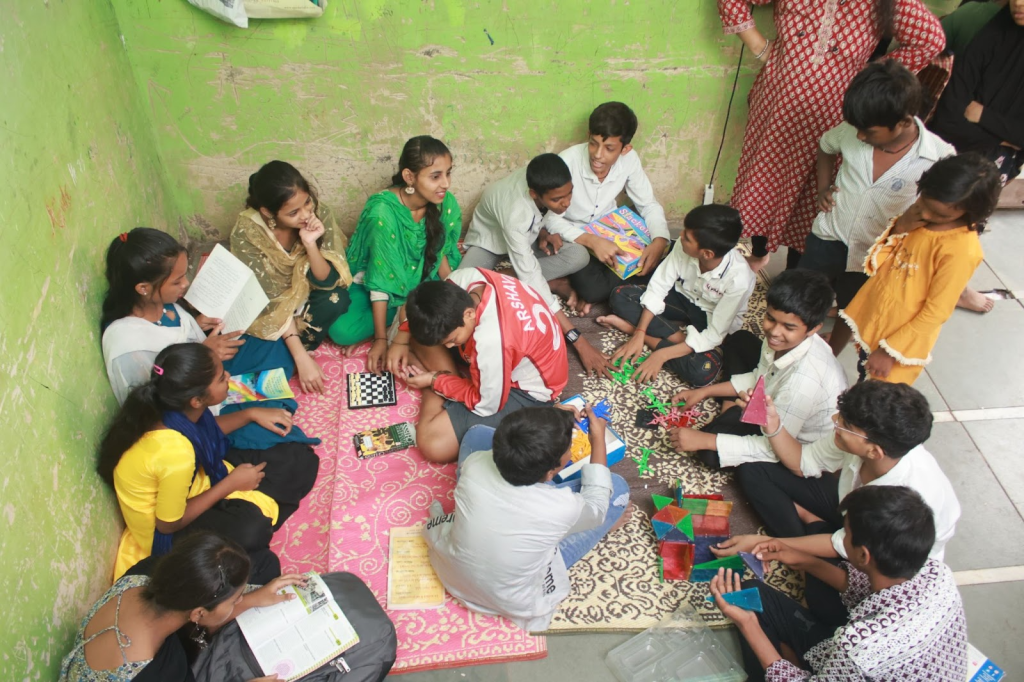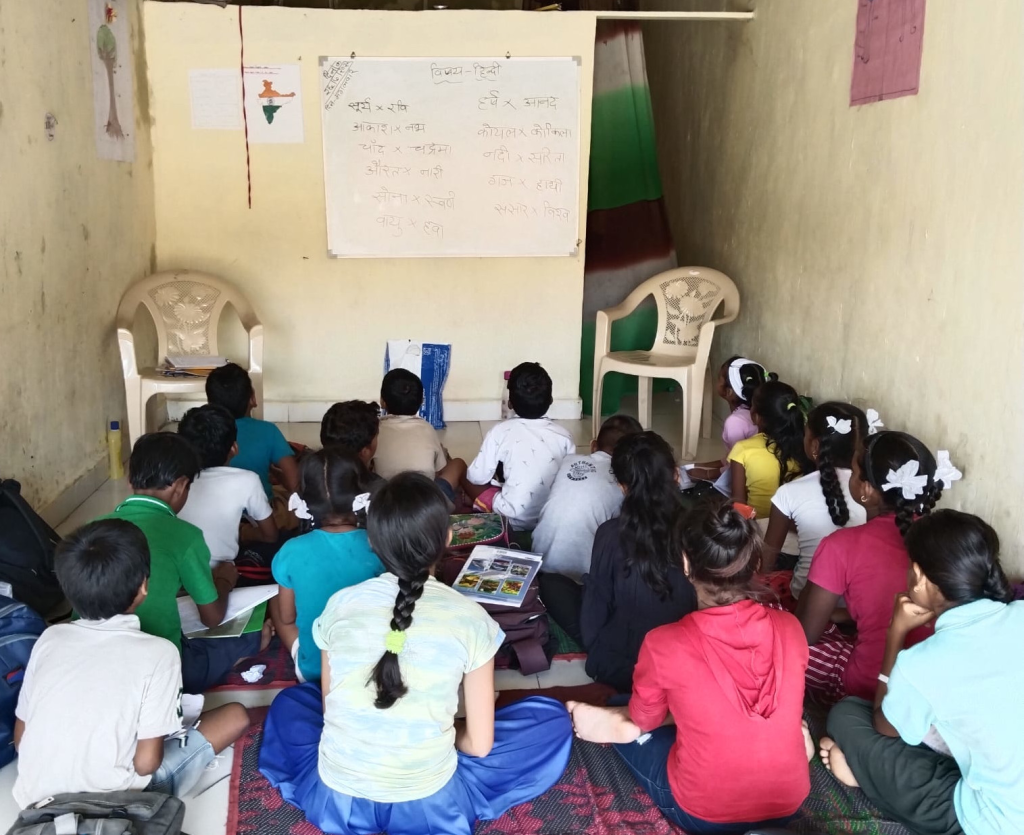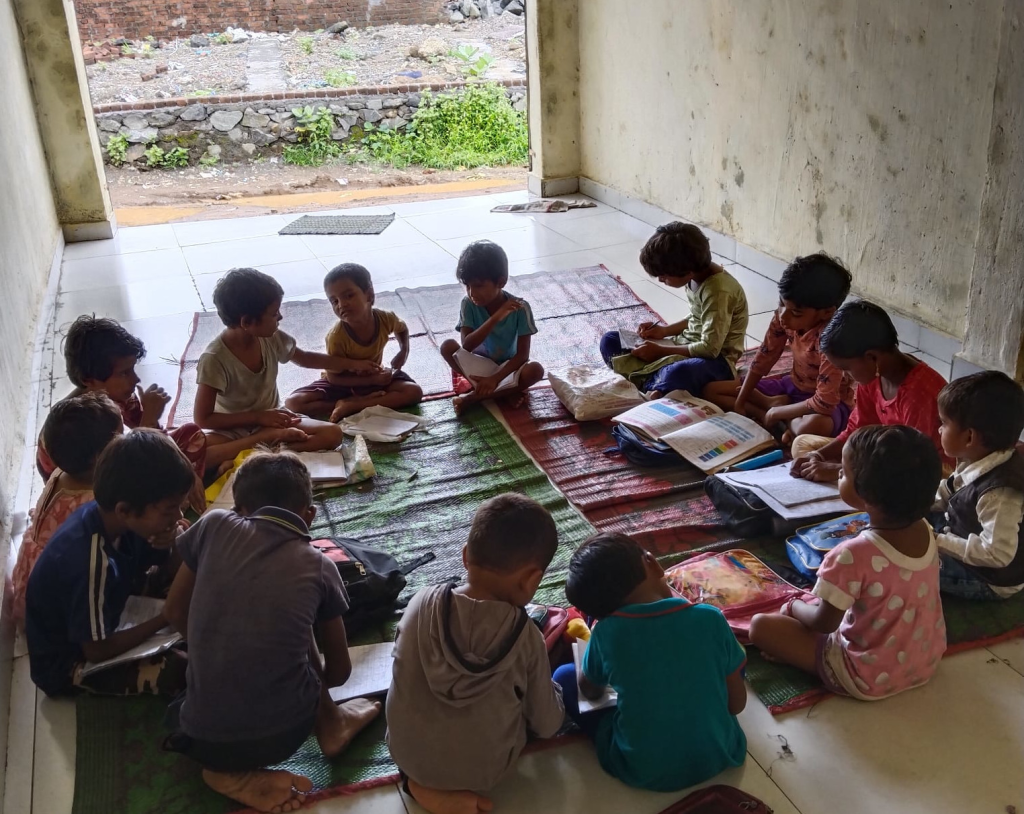Context
The pandemic and the long closure of schools severely impacted children in India. Decades of social protection policies designed and executed to tackle challenges in education and nutrition of children were undone by the impact of COVID-19. As many affordable private schools completely shut down or were unable to conduct online classes during the long school closures, it led to an increase in enrollment in already overburdened government schools. For many in vulnerable communities, who suffered loss of income, it resulted in children dropping out of schools completely or moving to government schools.
With the long closure of anganwadis, children stayed hungry or underfed, and couldn’t meet their nutritional requirements. India fell to the 94th spot among 107 countries in the Global Hunger Index of 2020. A study by Azim Premji Foundation showed that almost 60 per cent of school children in India couldn’t access online learning opportunities. The digital divide in our country was prominently displayed during the pandemic and created significant learning losses among children, which will take concentrated efforts to improve.
In this context, YUVA with the support of Dasra’s Back the Frontline initiative started four Child Resource Centres (CRCs) across four locations in the Mumbai Metropolitan Region, in Nalasopara, Malvani, Bandra, and Mankhurd, respectively. Each location presented unique vulnerabilities and challenges and was chosen after careful consideration and mapping of the communities’ needs. The teachers heading these centers were also from the community in which the CRCs were situated, so they came with the experiential knowledge of the community and were also trained by YUVA in child-friendly practices, teaching methodology, activity learning, ASER tools for evaluation, and child protection laws and child rights. This blog details the testimonials of teachers who run these centers, and of students and parents who have been able to avail of the services.

Sunita, a teacher at the Malvani Child Resource Centre
Sunita, aged 33 years, has roughly eight years of experience, teaching in balwadis for non-profits like Pratham and YUVA in her basti at Ambujwadi, Malvani. Along with this, she used to conduct bridge classes for dropout children to support them in their education and re-enroll them back into schools. She describes her basti as a densely populated urban informal settlement with a mixed population of Marathis, Pardhis (a tribal community), Muslims, and migrant workers.
Sunita lives with her brothers in a joint family along with her two daughters, aged 14 and 16 years. She recalls that a lot of nonprofits had started working in the area before the demolitions of 2005. A philanthropic trust working in the area back then had admitted her two daughters into a private school and had promised to pay the fees till they graduate the tenth standard. However, the trust closed down after a few years, and Sunita had to work to pay her daughter’s education fees. After the first lockdown, Sunita lost her source of livelihood and her two daughters had to drop out as she was unable to pay off their fees. And it was only after taking loans and starting work with YUVA again that the girls are now back to school.
As part of YUVA’s team, Sunita has done extensive mobilization and door-to-door surveys of this dense basti, comprising mostly daily wage workers. Most residents were severely impacted from the first lockdown onwards, and the subsequent loss of livelihood led to children dropping out of schools, parents, and children spending long hours enclosed at home. At this time, Sunita says she heard a lot of children complain of being strained by excessive household chores and facing the brunt of their parents’ frustration in the form of physical beatings. For those children, still in school, most parents did not have smartphones, or if they did in some rare cases, the number of children in the household meant that they would have to attend classes alternately. Some children along with their parents permanently moved to their villages while some went into child labour. Sunita observed some children who used to be in schools selling masks on the road.
Looking at this need, YUVA which has had a presence in Ambujwadi for several decades started the Child Resource Centre. The response to the Centre was overwhelming. At first, the team conducted a needs analysis to identify children who needed the support more urgently. Weekly meetings and training sessions helped the teachers adopt new child-friendly teaching techniques and ASER tools that help analyze each child’s learning level. Sunita says that using the ASER tool has helped her identify the areas where a child is weak. For instance, there were some who struggled with the recognition of numbers, so Sunita conducted a fun learning activity where on each child’s turn the child would have to throw a pebble on the correct numbered box drawn on the ground with chalk.
When we asked her about a particular memory from the Centre that has left a strong imprint, she recalled a 7-year-old girl, Sama. Sunita had been teaching her ‘addition’ in math when the schools were shut due to Covid-19. When the schools reopened and Sama was able to solve a math question before it was even taught in school, her mother was stunned. Sunita confirmed to her mother later that she had indeed learned to do those kinds of sums at the Centre.
Sunita says,
“Parents tell me that the children love to come to the Child Resource Centre. There have been days when the children have come to my doorstep because I was a minute or so late. They are very keen on coming to the Centre because they get to learn in an exciting manner. Parents have also been very supportive”.
Shimon, teacher at the Mankhurd Child Resource Centre
19-year-old Shimon is a third-year BCom student at NG Acharya College. He lives with his parents and his brother at the rehabilitation and resettlement (R&R) colony of Lallubhai Compound, Mankhurd. For the past seven years, Shimon has been part of Bal Adhikar Sangharsh Sangathan (BASS), a children’s collective working on community-based child rights issues in Lallubhai Compound. Through the collective, Shimon has been actively engaged in raising awareness in his community on child rights and child protection issues and connected with government and non-government entities to highlight these issues. For Shimon, this platform has helped him find confidence not only in public speaking but also to voice his opinions through writing articles and speaking on live TV for news channels.
With this experience in BASS, Shimon joined the Mankhurd Child Resource Centre as the teacher in-charge . The residents of the area where the CRC was located are predominantly informal workers and rag pickers. There are no government or affordable private schools in the locality. Hence, many children either don’t go to schools or go to madrasas and other informal institutions.
Shimon says that there is not a single child or youth in the community who has studied beyond 12th standard, and among the girls most have studied only till 10th standard. Parents are not very keen on educating girls as they want their daughters to marry early, and they don’t feel that the girls would be safe in school or in a job later. Cases of harassment and eve-teasing in the community further fuel this fear and create a sense of distrust. There have been many cases of child marriages in the locality. Through the BASS children’s collective, Shimon and his friends are trying to bring these conversations in the open and emphasize the importance of every child’s education.
Through his work at the CRC, Shimon learnt new teaching methodologies including the tools used by ASER to estimate basic learning levels. Coming from BASS, Shimon already had the experiential knowledge of child protection policies and child rights, which he is now using to build awareness among his students. Shimon uses various fun learning activities in his classroom to keep students engaged, including games, songs, learning with examples, math tricks, etc. Parents have been appreciative of this effort as they say that they have not seen the children this keen on going to the Centre to learn. A unique feature of this CRC is also that it holds special Saturday classes for the mothers and women of the community, who wish to study and learn the basics that would help them support their children and also achieve literacy. This came out as a need in the area during assessment and mobilization.
When asked about any particular memory that has left a strong imprint, Shimon says that he feels proud whenever any child comes back to the CRC, excited to learn more. Especially when they go home or to school and they are able to read English fluently, they see their peers, teachers, and parents being impressed, which makes them keen to learn more. The women who have been part of the Saturday classes have also praised Shimon for his passion towards teaching and making learning an enjoyable process for both children and women. For Shimon, it brings him great joy that he is now working with the same organization which helped him grow to be a confident young man and opened new doors of opportunity for him. Shimon wishes to pursue a master’s degree in social work, to continue and enhance his work in the development sector.
Sehdulnisa, parent of a child studying at the Mankhurd Child Resource Centre
Sehdulnisa’s daughter, 12-year-old Nasreen, studies at the Mankhurd Child Resource Centre. Nasreen studies at the Shivaji Nagar Municipality School. Before this, she was enrolled in a private school but because of the lockdown-induced setbacks to their livelihoods, she is enrolled in the government school at present. During the lockdown, Nasreen and her siblings could not attend any of their online classes because the family had no smartphones. Sehdulnisa felt relieved when the CRC at Mankhurd was set up as it became a means of education for her children, who have suffered a long gap in their education. It also meant that the children would not sit idle at home or engage in any harmful activity. They would spend two hours productively at the Centre and would also get homework that would keep them engaged. Sehdulnisa also appreciates that the Centre not only focuses on academics but also teaches the children about values and manners. Sehdulnisa wishes for her children to be able to complete their higher education and hopes that the Centre would continue to offer the support they are providing to the children in the community.

Schools in Nalasopara were closed during the lockdowns, and since most parents in Nalasopara’s Jadavpada did not have access to smartphones, children were not able to attend online classes. But as schools reopened, they demanded full fees for the last two years. As most parents were migrant workers in the informal sector who lost their livelihoods during this period, it was not possible for many to send their children back to school. Even the ones who were studying in affordable private schools in the area, found out when migrating back to their home states that these schools were not formally registered. Hence, many children were not able to claim school leaving certificates. This situation has created a lot of mistrust in the community, and many parents don’t want to send their children to these private schools. Since there are no anganwadi centers and the is located at considerable distance from the Nalasopara station, there aren’t many options for these parents. Due to these gaps, the Child Resource Centre and a balwadi were set up in this area.
Ayush, student at the Nalasopara Child Resource Centre
Ayush is 13 years old and studies in the 8th Standard at the Gyan Darshan English School. His parents are migrant workers from Pratapgarh in Uttar Pradesh. He lives in the Jadavpara basti of Nalasopara with both of his parents and two siblings. His younger sister Sneha, who is 10 years old, also accompanies Ayush to the CRC for their daily studies. Ayush’s father works as a cashier in a petrol pump and his mother is a homemaker. While Ayush is happy about his school reopening, the CRC gives him the space for after-school studying. While the community has frequent power cuts especially post-sunset, for Ayush and his sister the Centre acts as a refuge for play and studies. Shanti, the teacher at Nalasopara CRC helps Ayush and his peers with homework and assignments while also engaging them in fun learning activities.

Ayush likes English the most among his subjects at school. While he finds it easy, he also feels English is an essential language for his generation. For him, science and math are the hardest – since there’s no one at home to teach and help him. Apart from this need which is being met by the Centre in the community, the space also helps children like Ayush channel their creativity, through activities like poetry writing, storytelling, craft, and drawing.

Afreen and Seham, students at the Bandra Child Resource Centre
Afreen Ansari is 12 years old and studies in the 6th standard at the Rustom High School. She stays with her family of six, with two parents, two sisters, and one brother at Behramnagar, a slum in Bandra.
Afreen’s father, the sole breadwinner in her family, works as a garment salesperson and suffered a terrible blow to his income with the onslaught of COVID-19. Despite savings, it was hard for the family to make ends meet during this time. Even with online classes, the school fees of Afreen and her siblings had to be paid. With the opening of schools, Afreen’s father was still not comfortable sending his children to school because of the fear of them contracting COVID-19. Hence the children continued online classes while also attending afternoon classes at the CRC. The Centre not only helps Afreen do her homework but also offers a space for her to meet other children. At home, between household chores and helping her father with his work, Afreen neither has the physical space nor the time to study or play. She looks forward to her time at the Centre, and, especially on Saturdays, when she goes to the nearby playground to play netball with the girls in her colony. For two years now Afreen and her siblings have not been to school, for her this Centre is the only learning space. Afreen wants to grow up to be a doctor, so she can offer free treatment to vulnerable people.
Seham Khan is 13 years old and studies in the 8th standard at the Rizvi Spring Field High School. She lives with her five-member family, comprising her parents and two siblings. Seham comes to the CRC with her sister and brother. Her father works as a tailor but his work stopped during the lockdowns which created many financial woes for the family. Now that work has started again, Seham also helps her father in stitching buttons in the garments that he tailors. When school was closed during COVID-19, Seham and her siblings could attend online classes with their father’s phone and get their doubts cleared at the Centre. Seham and her siblings like coming to the Centre even after school reopened as they get to learn beyond textbooks here. Seham particularly likes storytelling, reading, and helping her teacher with other younger students at the Centre. She enjoys craft classes the most as they are provided with all the material to explore their creative interests.
Through this initiative, the four CRCs set up across the Mumbai Metropolitan Region, became a beacon of hope for many children like Afreen, Ayush, and Seham. The support from the community and the efforts of the teachers facilitated the creation of a safe space for children, not just those who were going to school but also for those who had dropped out of school.
As incidence of Covid-19 dropped and schools re-opened, CRCs helped children who had suffered a break in their education in rejoining formal education by addressing the learning gaps and the drop in interest induced by the closure of schools. After facilitating this transition process, the CRCs were wound down by April 2023. Speaking about the crucial role played by the CRCs, Prakash Bhawre, who lead the CRC initiative in the Mumbai Metropolitan Region, says that,
“The CRCs helped establish the importance of education in the community, by sustaining learning levels and interests in the children through the difficult Covid-19 period. CRCs provided a shared community space where children could not only continue their education but also learn life skills required for their holistic development. Such spaces are needed even today, where children of the community can come and express themselves, raise issues relevant to them and avail sustained support.”
Echoing Prakash, Geeta Dabre, who coordinated the CRC initiative in Nalasopara (E) says that,
“Since we focused on the most marginalized children in the community, the parents wanted us to continue operating the CRCs since access to tuition centers in the area is very expensive. Moreover, CRCs were the only spaces in the locality where children could gather for various learning and developmental activities. Whenever we go to the area, parents ask us to reopen the CRCs.”
The continued demand for CRCs demonstrates that the centers not only served short-term Covid-19 induced needs but also addressed long-standing need for collective and supportive spaces for children and youth.


